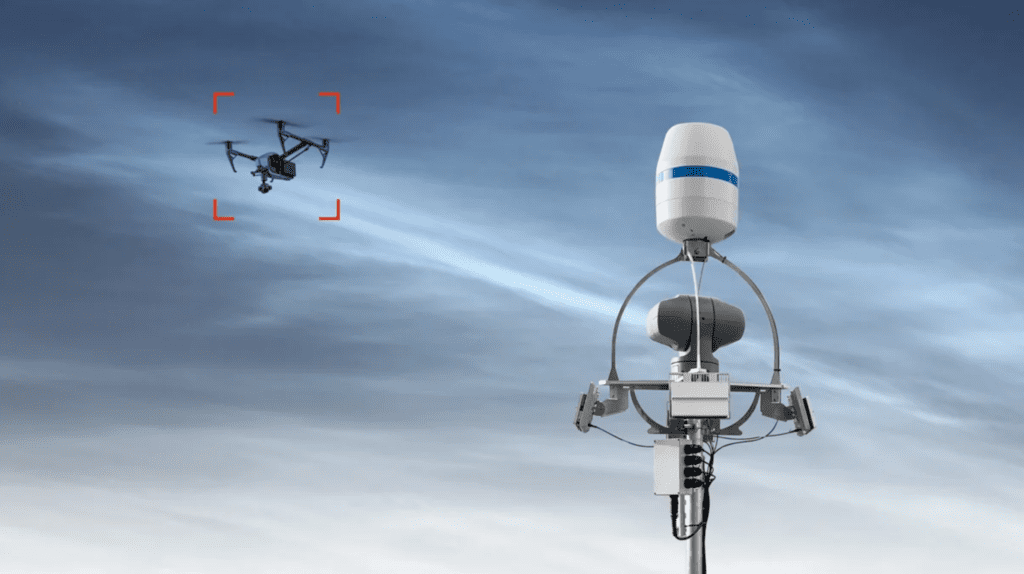Los equipos antidrones más populares
Contexto industrial
System Composición
Sistema de detección
Sistema de detección de RF
Sistema de detección por radar
Sistema de seguimiento óptico por electrones (EOTS)
Sistema de contador
Equipo Soft-kill
Bloqueador de drones
Drone Spoofer
Equipo de matanza
Equipo láser
Contexto industrial
Con el rápido desarrollo de la inteligencia artificial, la tecnología de las comunicaciones y la tecnología de la ingeniería aeronáutica, el campo de aplicación de los UAV es cada vez más amplio. Desde el uso comercial hasta las operaciones militares, los drones se han convertido en parte integrante de la sociedad moderna.

Como puede verse en la Figura 1, el mercado mundial de vehículos aéreos no tripulados muestra una tendencia ascendente continua. Esto también significa que nos enfrentaremos a los riesgos potenciales de cada vez más drones. Para reforzar la gestión de los Uavs, Estados Unidos, China, Japón y la Unión Europea han introducido sucesivamente la normativa de gestión de Uavs RID. Sin embargo, el simple modo RID puede fallar ante las actividades de vuelo no autorizadas de los Uavs. Por lo tanto, necesitamos una solución antidrones más completa. Como el radar y la optoelectrónica, y los sistemas soft kill y hard kill.
Composición del sistema
Antes de empezar nuestra descripción de un sistema anti-drones, tengo dos preguntas:
- ¿Cómo encontrar un dron?
- ¿Cómo atacar a un dron?

Esta es la cuestión central en la quech construimos nuestro sistema anti Uas.
Empezamos con la primera pregunta, "cómo encontrar un dron". En este momento, lo primero que probablemente le venga a la mente es el radar. Efectivamente, el radar también desempeña un papel importante en la detección de drones. En la detección de drones se utiliza principalmente el radar phased array. Además del radar, existen dispositivos de detección por radiofrecuencia y dispositivos de seguimiento optoelectrónicos. Cada uno de estos dispositivos puede funcionar de forma independiente o utilizarse conjuntamente para complementarse entre sí.Así pues, puede decidir cuál de estos dispositivos comprar en función de su presupuesto económico. Comprar todo es la mejor opción, y si dispone de fondos limitados, elegir un sistema de detección por radiofrecuencia será la mejor elección.

Una vez resuelto el problema de cómo detectar drones, hablemos de "cómo atacar a un dron". En primer lugar, dividimos los métodos anti-UAV en métodos soft-kill y hard-kill. En las aplicaciones cotidianas, los más comunes son los dispositivos soft-kill, como los dispositivos de interferencia de drones y los equipos de suplantación GNSS. El "hard kill" se refiere generalmente a la destrucción física, como el láser.
¿Por qué hay más gente que opta por el asesinato suave?
Debido a que el uso de la interferencia de ondas electromagnéticas suave matar el equipo es más simple, el precio es más barato, en el volumen y el peso son relativamente más apropiado.
Sin embargo, el método de muerte suave tiene algunos defectos, que pueden ser inválidos para Uavs especiales con fuerte capacidad anti-jamming. Aquí es donde entra en juego la matanza dura. Sin embargo, el soft kill puede básicamente hacer frente a la gran mayoría de Uavs en la actualidad, por lo que los equipos de soft kill juegan un papel muy importante en el anti-drone. No hay que menospreciar los equipos soft kill, los equipos soft kill del mercado actual pueden cubrir toda la banda de frecuencias de comunicación de los UAV.
Láser como el medio más poderoso para matar con fuerza, el dron no debe ignorar su existencia. Uno podría preguntarse por qué no disparar al dron sin un arma, ¿no sería mejor? Hay que saber que es muy difícil dar en el blanco con un dron de vuelo rápido manejado por un humano. El equipo láser se guía para completar la acción de apuntar al objetivo a través de los datos de la detección equipos. Las desventajas de los láseres son que son caros, complejos y tienen un alcance limitado.
Los dispositivos mencionados pueden reunirse para formar un sistema anti-UAV completo que realice la tarea de encontrar y luego contrarrestar los Uav. Esta es la respuesta a las dos preguntas que he mencionado antes. Presentaré el contenido específico de los dispositivos a partir de estos dos aspectos. Presentaré el contenido específico de los equipos a partir de estos dos aspectos, uno es el sistema de detección, y el otro es el sistema de contraataque.
Sistema de detección
Detección RF
¿Qué es la espectro detección:
La tecnología de detección del espectro es una tecnología para identificar, medir y localizar señales de radio mediante el análisis de la distribución y las características de las señales en el dominio de la frecuencia. En los equipos de detección del espectro de los UAV, la tecnología de detección del espectro se utiliza principalmente para controlar y analizar la señal de radio aérea en tiempo real, a fin de obtener los parámetros clave, como la frecuencia, el ancho de banda y la potencia de la señal.
La advantges de RF detección:
- Detección pasiva, no transmiten señales activamente
- Las ondas de radio viajan lo suficientemente lejos como para cubrir una gran área
- Puede realizar el posicionamiento de alta precisión del UAV
- El coste de la detección por radio es muy bajo en comparación con el radar, la optoelectrónica, la acústica y otras tecnologías de detección de vehículos aéreos no tripulados.
La disaVentajas de RF detección:
- El cifrado de la señal es difícil de descifrar
- Vulnerable a las interferencias electromagnéticas
- El FPV es difícil de localizar
Detección por radar
¿Qué es la radar phased array:
El radar phased-array es un radar de barrido electrónico controlado por fase. Su capacidad de conversión rápida y precisa del haz permite al radar completar la exploración de todo el espacio en 1 minuto. El llamado radar phased array es un radar compuesto por un gran número de elementos de radiación idénticos. Cada elemento de radiación
es controlada independientemente por el controlador de onda y el desfasador en fase y amplitud, lo que permite obtener un diagrama de radiación y una dirección del haz precisos y predecibles.
El radar anti-Uas detecta principalmente objetivos "bajos y pequeños lentos", a menudo utilizando las bandas X y Ku, y sintetiza la doble polarización totalmente coherente, el procesamiento inteligente de datos de radar, la fusión de datos de múltiples fuentes y otras tecnologías, que pueden realizar la detección todo tiempo, activa, multiobjetivo y fina de "objetivos bajos y pequeños lentos" + objetivos "micrometeorológicos de baja altitud".
La aVentajas de rdetección de adar:
- Rápida velocidad de exploración, haz flexible y controlable
- Largo alcance de detección
- La capacidad de detección de objetivos es grande, y se pueden vigilar y seguir cientos de objetivos simultáneamente en el espacio aéreo.
- Gran capacidad antiinterferente
- Gran capacidad de adaptación a entornos complejos
- Alta fiabilidad
La disaVentajas de rdetección de adar:
- Coste elevado
- El equipamiento es complejo
- Hay puntos ciegos a corta distancia
- El alcance de exploración del haz es limitado
Sistema de seguimiento óptico por electrones (EOTS)
Qué es el sistema de seguimiento óptico de electrones:
Los equipos optoelectrónicos de identificación y seguimiento combinan la tecnología de imágenes de luz visible e infrarrojos, recogen la información óptica del objetivo a través del sistema óptico y la convierten en señales eléctricas para su procesamiento y análisis, a fin de realizar la identificación y el seguimiento rápidos y precisos del objetivo.
La aVentajas de sistema de seguimiento óptico de electrones:
- Cámara de alta definición y precisión
- Gran capacidad de reconocimiento de objetos
- Transmisión de imágenes en tiempo real
- Seguimiento automático de objetivos
La disaVentajas de sistema de seguimiento óptico de electrones:
- Afectados por el medio ambiente
- Sofisticación técnica
- Fuerte dependencia del hardware
- Las cámaras ópticas son más caras
Sistema de contador
Tras detectar el dron mediante el sistema de detección, es necesario resolver el problema de cómo defender el dron. Las formas de defender a los UAV suelen dividirse en dos categorías principales: muerte suave y muerte dura. El soft kill se consigue principalmente mediante tecnología electrónica, mientras que el hard kill utiliza la destrucción física. En la actualidad, la más común es la tecnología de muerte suave, porque es más rentable y menos difícil de implementar. La tecnología soft kill aplica la tecnología de ondas electromagnéticas para interferir con la señal de control remoto y la señal de transmisión de vídeo del UAV mediante la transmisión de la misma señal de frecuencia. Esta tecnología se utilizó por primera vez en dispositivos de interferencia de drones, y luego se convirtió en dispositivos de suplantación de identidad de drones. A continuación, veamos los dispositivos de señuelo para drones.
Bloqueador de drones
Qué es el inhibidor de drones:
Utilizando tecnología de ondas electromagnéticas de alta frecuencia, la onda electromagnética se transmite en la misma banda de frecuencia que la banda de comunicación del UAV, lo que interfiere con la recepción de instrucciones del mando a distancia por parte del UAV, provocando que éste no pueda analizar normalmente las instrucciones y señales de vídeo del mando a distancia, perdiendo así el control y regresando o aterrizando según el procedimiento preestablecido.
Normalmente, clasificamos los jammers en varias categorías según su estructura, a saber, jammers fijos, jammers de mochila y jammers de mano. A continuación he enumerado algunas imágenes que corresponden a cada uno de estos tipos.
Debe decidir qué estructura del dispositivo de interferencia elegir en función de su caso de uso específico. (¿Cómo elegir un interferente adecuado?)
La aVentajas de drone jammer:
- El precio es barato. Rendimiento de alto coste
- Puede cubrir múltiples bandas de frecuencia de comunicación
- Bloqueo simultáneo de varios objetivos
La disaVentajas de drone jammer:
- La distancia de interferencia es limitada
- Alta potencia de los equipos
- No se causan daños directos al dron, que sólo puede verse obligado a regresar a su punto de partida o a aterrizar en un lugar seguro.
Drone Spoofer
Qué es el drone spoofer:
Al enviar señales GPS engañosas, el dron no puede obtener información precisa sobre su posición, lo que provoca un desplazamiento de su posicionamiento o la pérdida de su capacidad de navegación.
En el mercado existen principalmente equipos de suplantación estacionarios y equipos de suplantación portátiles. No hay mucha diferencia en la estructura del dispositivo de suplantación GNSS, lo que nos debe preocupar es que cubre las señales de varios sistemas de posicionamiento por satélite. Conocemos la corriente principal de los cuatro principales sistemas de posicionamiento global: GPS, Beidou, Galileo, Glonass. En general, necesitamos señales de los cuatro sistemas. Dado que los Uav comunes tienen al menos dos localizadores GNSS, muchos de los Uav de DJI, por ejemplo, pueden tener tres o incluso cuatro localizadores. Así que para ser infalible, lo mejor es que nuestro dispositivo de suplantación cubra los 4 GNSS principales.
La aVentajas de drone spoofer:
- Bajo consumo del dispositivo
- Puede afectar directamente al vuelo del dron e incluso hacer que se estrelle.
- La cobertura es mayor que la del bloqueador
La disaVentajas de drone spoofer:
- El precio es relativamente más caro que jammer
- Incapaz de hacer frente a drones sin capacidades GNSS
- Afecta a la funcionalidad GNSS de todos los dispositivos de la zona


